List of teams qualified for 2nd FIDE Chess Olympiad for People with Disabilities

The 2nd Chess Olympiad for People with Disabilities will take place from October 19 to 26, 2025, in Astana, Kazakhstan. Organized by FIDE and hosted by the Kazakhstan Chess Federation, this major international event highlights FIDE’s ongoing commitment to inclusion and accessibility in the global chess community. The Olympiad will bring together up to 34 teams from across the world, composed of players with visual, hearing, and physical impairments. Each team will consist of four players (with at least one from each gender), one captain/reserve, and one accompanying person. The competition will be held at the Paralympic Training Centre in Astana, a venue specially adapted to accommodate the needs of all participants. So far, 32 teams have qualified for the event, with two teams to be nominated by the FIDE President. Continental qualification Europe – 9 teams Poland Hungary Israel Ukraine Germany Croatia Czech Republic North Macedonia Serbia Asia – 7 teams FIDE Philippines India Iran Bangladesh Myanmar Uzbekistan Americas – 6 teams Cuba Venezuela Argentina Colombia USA Chile Africa – 5 teams Egypt Zambia Zimbabwe Tunisia Uganda Teams from the FIDE affiliated organizations – International Associations of Players with Disabilities – 3 teams International Braille Chess Association (IBCA) International Chess Committee of the Deaf (ICCD) International Physically Disabled Chess Association (IPCA) Nominations of the FIDE President – 2 teams TBD TBD Teams from the hosting federation – 2 teams Kazakhstan 1 Kazakhstan 2 Photo: Mark Livshitz The first edition of the Chess Olympiad for People with Disabilities was held in Belgrade, Serbia, in 2023, marking a historic milestone for accessible chess. The event drew global attention for its inclusive spirit and high-level organization, laying the foundation for a growing tradition. 2nd FIDE Chess Olympiad for People with Disabilities Regulations (PDF) For registration and queries, federations are encouraged to contact: dis@fide.com.
FIDE Women’s World Cup Final, Game 1: Narrow escape for Humpy Koneru; solid start by Divya Deshmukh

Tan Zhongyi and Lei Tingjie also split the point in a balanced game The first game of the final was as exciting as it gets. Divya unleashed some excellent opening preparation and was on the verge of scoring a win in under 25 moves. However, Humpy defended tenaciously and capitalized on a few inaccuracies to salvage a draw. The second game of the match will be played tomorrow, with Humpy having the white pieces. In her post-game interview, Humpy admitted she had narrowly escaped defeat: “I think she was clearly better after 12.Rb1 instead of 12.Nc4. After that, I’m not sure what was going on, but it was very complicated.” In the third-place match, Tan and Lei split the point just after the 30-move threshold. Lei will have the white pieces in tomorrow’s second game, with the winner securing the final Candidates qualification spot. Let’s take a closer look at the games. Although Divya is comfortable playing both 1.e4 and 1.d4, the former has been her weapon of choice throughout the tournament in Batumi. So, it came as a surprise to see her open today’s game with 1.d4 — and even more so when Humpy Koneru responded with the Queen’s Gambit Declined, a defence she had largely set aside since 2005. Humpy reintroduced the Queen’s Gambit Declined to her repertoire in 2023, but has used it sparingly compared to her other openings. Her most recent outing in this line — a loss to Lei Tingjie in Norway Chess 2024 — followed the variation featured in today’s game. Reflecting on that earlier defeat, Humpy said in her post-game interview: “I think that she prepared on this game and I just misplayed the opening and she got a big advantage.” The first critical moment came very early. According to the database, this position has appeared in about thirty elite-level games — all of which continued with 7.f3, reinforcing the e4 pawn and guarding against 7…Nxe4. But Divya deviated with 7.Be2 — a rare move, though not a novelty. GM Evgeny Bareev had employed it against GM Vassily Ivanchuk back in 1992. Today, engines rank it as their third choice. Humpy spent around ten minutes considering her reply and ultimately declined the pawn with 7…Bb7, possibly wary of running into home preparation. Undeterred, Divya castled and offered the pawn again. This time, Humpy accepted — and suddenly the game became sharply tactical, reminiscent of the original Bareev–Ivanchuk clash more than three decades ago. According to the engine, Divya missed an opportunity to achieve an opening advantage on move twelve but certainly on move fourteen she went wrong. In this critical position, the computer recommends 13…Kd8 for Black. After 14.Qe2 Re8, the position appears dangerous, but with precise play, it remains objectively equal. However, Humpy opted for 13…Kf8?, a natural-looking move that unfortunately gave her opponent a real chance to seize the initiative. “I don’t remember exactly the reasons, but I felt that 13…Kd8 was the wrong move,” Humpy said after the game. Sensing that an opportunity had arisen, Divya went into deep thought but ultimately missed the most punishing continuation. She played 14.Bxb7?, grabbing material but allowing the position to equalize after 14…Qxb7 15.Qe2 Nc6 16.d5, when the excellent defensive resource 16…h5! returns the extra piece and neutralizes White’s initiative. “I felt that after 16…h5 I was out of danger,” Humpy reflected. https://www.youtube.com/watch?v=G28SnnLdqsQ&t=7s Instead of capturing on b7, Divya should have played 14.Qe2!, maintaining a crushing +2.5 advantage according to the engine. The move intensifies the pressure on the exposed Black king and keeps White’s attacking momentum alive. Of course, finding such a precise continuation over the board, especially under time pressure, is never easy. Divya was visibly distressed at the end of the game after missing her chance to secure the win — the disappointment was evident on her face as she sat at the board. Even so, both players graciously spent time with fans who had been waiting all afternoon for a photo opportunity and a chance to meet their chess idols. Although all eyes were focused on the main game of the finals, the battle for third and fourth place was equally significant. The winner would secure the third qualifying spot for the Candidates Tournament, plus a €5,000 pay jump. Both Chinese players, good friends and frequent training partners, brought their best to the board. Tan opened with 1.c4, and the game soon transposed into a well-known position from the Queen’s Gambit Declined, Exchange Variation. Both players blitzed out their moves rapidly, demonstrating excellent theoretical knowledge. Instead of pursuing the mainstream minority attack plan—characterized by 10.Qc2, followed by 11.Rab1 and a later b4-b5—Tan opted for a less common approach with 10.a4. The idea was to play 11.a5, aiming to clamp down on the queenside. Recent games from elite players such as Caruana, Praggnanandhaa, Vidit, and Grischuk seem to support this strategy. The pace slowed as the game transitioned into the middlegame around move fifteen. Both players maneuvered their pieces carefully, seeking out the best squares. Their accuracy remained impeccable—no outright mistakes were made. However, a couple of small inaccuracies by Tan on moves 29 and 30 shifted the balance toward Lei. Though the engine suggests Black holds a modest +1 positional advantage—roughly equivalent to a pawn—the position was blocked, and White’s knights stood powerfully in the centre. Black’s slight edge mainly lay in a better pawn structure. Lei offered a draw just as her clock ticked down to fifteen minutes. In the end, both players left the hall together in good spirits, their friendship evidently undiminished by the fierce contest. Follow the games live and watch the action with expert commentary provided by GM Valeriane Gaprindashvili and IM Almira Skripchenko on the FIDE YouTube channel. Written by IM Michael Rahal (Batumi, Georgia) Photos: Anna Shtourman About the tournament: Scheduled to take place from July 6th to July 28th, the 2025 FIDE Women’s World Cup will gather together in Batumi (Georgia) the world’s best female chess players. A total of
International Organizer Seminar announced as part of World Youth Chess Championship 2025
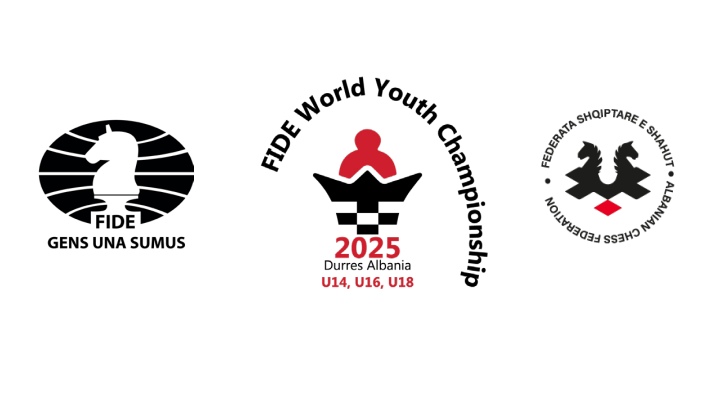
As part of the World Youth Chess Championship 2025 in Durrës, Albania, the Albanian Chess Federation, in cooperation with FIDE WOM and under the auspices of the FIDE Events Commission (EVE), will host the International Organizer Seminar. This seminar is designed to train and certify organizers of international chess events in compliance with FIDE regulations. Participants who successfully pass the final exam will receive the official EVE IO Norm Certificate, issued by FIDE. Seminar details Dates: October 11–12, 2025Location: Grand Blue FAFA Resort Hotels, Durrës, AlbaniaLanguage of instruction: EnglishParticipants: Maximum 20Participation fee: 100 Euros Schedule Saturday, October 11Session 1: 10:00 – 13:00 (CET +1)Session 2: 14:00 – 16:30 (CET +1)Sunday, October 12Session 1: 10:00 – 13:00 (CET +1)Session 2: 14:00 – 15:30 (CET +1)Final Exam: 15:30 – 16:30 (CET +1) Seminar topics FIDE Events Commission Regulations (mission, structure, competition regulations, bid procedure) FIDE Title Regulations FIDE Rating Regulations How to Organize Chess Tournaments Fair Play Guidelines FIDE LecturerOzgur Solakoglu (TUR) – IO, IA, FT, FM Assistant LecturerAnastasia Sorokina (AUS) – IO, IA, FPE, FT, WIM Special Participation offer for womenAs part of the FIDE WOM event, the first 10 registered female participants will receive free participation. Additionally, the Albanian Chess Federation has the right to nominate 2 participants free of charge. Registration & contact: nadzeya.krauchuk@gmail.com Parallel events like cultural visits, chess events and seminars, will be announced in due time.
FIDE Women’s World Cup Round 6: Humpy clinches victory in thrilling tiebreak
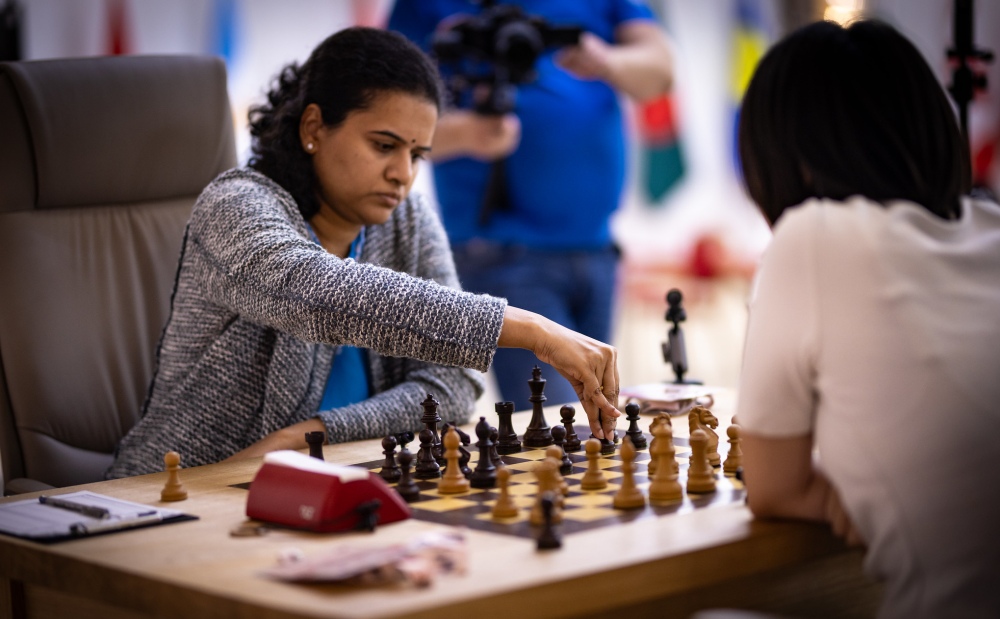
After tomorrow’s rest day, Humpy will face off Divya in the final Something extraordinary is happening in Indian chess — and the world is starting to take notice. India has taken the global chess stage by storm in 2024, delivering one historic moment after another. First came the unprecedented double triumph at the Budapest Olympiad, where India clinched gold in both the Open and Women’s sections. Then, Gukesh D, the teenage sensation from Tamil Nadu, became the World Chess Champion, etching his name in history as the youngest undisputed champion in the modern era. And now, in a development that underscores the country’s growing stature in women’s chess, India have two players in the final of the Women’s World Cup — a first in the event’s history. On one side is the prodigious Divya Deshmukh, just 19 years old, who stunned former Women’s World Champion Tan Zhongyi with a clinical 1.5–0.5 victory in the classical games. On the other is the ever-reliable Humpy Koneru, India’s top female player for nearly two decades, who booked her place in the final this afternoon after a thrilling six-game tiebreak victory over Lei Tingjie at the Batumi Grand Bellagio. If 2024 is any indication, Indian chess isn’t just rising — it’s redefining the global chess landscape. It took six fiercely contested games for Humpy Koneru to secure her place in the final, edging past Lei Tingjie with a final score of 5–3. The match, marked by tense moments and momentum shifts, showcased both players’ resilience and rapid skills under pressure. The contest began with two 15+10 rapid games, both ending in draws. Lei missed a clear winning opportunity in the first game, and Humpy later acknowledged her slow start: “It was a very tough match. Initially, I played quite badly with the Black pieces and she always had the advantage.” The breakthrough came in the 10+10 rapid section, where Lei struck first with a win in Game 3. But Humpy responded with steely determination, leveling the score in Game 4: “After the loss, it was a very difficult situation, but I was able to come back.” Heading into the 5+3 blitz tiebreaks with everything on the line, Humpy displayed her composure and tactical sharpness, winning both games in time scrambles to seal the match. https://www.youtube.com/watch?v=K_85695yDcg Reflecting on the battle, Humpy was gracious in victory: “I played a bit shaky in the rapid, but she also gave a very good fight. It could have gone either way.” Looking ahead to the final, Humpy highlighted the significance of an all-Indian clash against Divya Deshmukh: “I think it’s one of the happiest moments for chess fans because now the title will go to India for sure. But of course, as a player, tomorrow will be quite a tough game as well—Divya has played tremendously well in this whole tournament.” As Humpy advances to the final, her performance not only underlines her enduring class but also marks a proud milestone for Indian chess. Let’s take a closer look at some of the key moments of the match. In the opening encounter of the 15 + 10 rapid tiebreak, Humpy narrowly escaped a dangerous position. Lei Tingjie missed a golden chance to seize a decisive advantage with the intuitive sacrifice 19.Bxh6! gxh6 20.Qd2, initiating an unstoppable kingside attack. Despite spending nearly a minute evaluating the idea, Lei likely abandoned the line due to the lack of an immediately forced win — a common practical decision under time pressure. Humpy survived the scare, and the game eventually ended peacefully. Though the second game concluded in a solid draw, it was clear that Humpy held the upper hand throughout. Lei finally broke through in the third rapid game, now at a 10 + 10 time control. In an already slightly worse position due to weak light squares, Humpy blundered with 22…h5?, allowing the powerful response 23.Bc4!, simultaneously threatening the rook on e6 and the vulnerable f7 pawn. After 23…Rb6 24.gxh5+ Nxh5 25.Nxh5 Kxh5 26.Bxf7+ White emerged a clean pawn up. Humpy mounted a determined defence, but Lei converted her material advantage flawlessly to clinch the win. After this game, Lei was seen taking a short break in the lobby, quietly refocusing for what could be the decisive fourth rapid game. The fourth 10 + 10 rapid game was all Humpy, but even at the end she had to be careful. Humpy found the accurate 38.Qc7! forcing resignation, side-stepping the trap 38.fxe3? Qe4!, and it’s Lei who can force at least a perpetual check, if not more. After this comeback, the vibe in the room was that Humpy was on a roll, while Lei might have been slightly discouraged. Even so, both 5+3 blitz games were tremendously exciting and ultimately decided by tactics. The following moment in the fifth basically gave Humpy the key to the final. Black has to be very careful here – the extra pawn isn’t worth as much as the tactics on the seventh and eighth rank. With just a few seconds on her clock, Lei blundered with 44…Ra6?, and after 45.Qd7! hitting f7, 45…Qf8 46.Rc8, she lost her queen and the game. Instead, the correct move order was 44…Qf8! followed by 45…Ra8, and it should be a draw. Written by IM Michael Rahal (Batumi, Georgia) Photos: Anna Shtourman About the tournament: Scheduled to take place from July 6th to July 28th, the 2025 FIDE Women’s World Cup will gather together in Batumi (Georgia) the world’s best female chess players. A total of 107 players from 46 different federations are set to participate in the event, including seventeen of the current top twenty! Chess legends, seasoned professionals and emerging talents will play for the $50,000 first prize, in addition to three qualifying spots for the Candidates. The full pairings tree and day-by-day results can be found on the Women’s World Cup website.
FIDE World Youth Championships 2025: Registration deadline approaching

FIDE and the Albanian Chess Federation invite all national chess federations to participate in the 2025 FIDE World Youth Chess Championships (U14, U16, and U18). The competitions will be held in Durrës, Albania, from October 3 (arrival) to October 16 (departure). Each national federation may register one official player in each category (Under 14, Under 16, and Under 18, Open and Girls). This totals six official players plus one accompanying person (with a valid FIDE ID) per federation, all of whom are invited by the organizers. Additionally, players who finished 1st–3rd in the 2024 World Youth Championships (U14, U16, U18), as well as the gold medalists of the most recent Continental Youth Championships, earn the personal right to participate in the corresponding or a higher age category. Registration deadline: August 2, 2025. Invitation letter and regulations (PDF) FIDE World Youth Chess Championships 2025 official website: worldyouth2025.fide.com E-mail: worldyouth@fide.com
Alexandr Predke wins Serbia Open 2025

Serbian grandmaster Alexandr Predke emerged as the winner of the 5th International Summer Chess Festival Serbia Open 2025, edging out six players on tiebreak. The top seed lived up to expectations as a pre-tournament favorite and came out on top, despite losing five rating points along the way. A true chess spectacle, the 5th International Summer Chess Festival Serbia Open 2025 was held from July 14–23 at the “Metropol Palace” hotel in Belgrade. The event brought together over 500 players from 42 countries. The festival followed Swiss system format and featured tournaments in three categories: Masters (9 rounds), Challengers, and Amateurs (7 rounds). As anticipated, the Masters event proved to be intensely competitive, with the final round ultimately deciding the winner. One of the tournament’s biggest surprises was the impressive performance of 14th seed IM Can Durak from Turkey, who took the lead in Round 5—though his reign at the top was short-lived. Heading into the final round, five players shared the lead with 6.5/8 points, including eventual champion Predke. The key games between Ioannidis Evgenis vs. Alexandr Predke, and Can Durak vs. Evgeny Postny (Israel), ended in draws. Meanwhile, Suresh Harsh (India), Bojan Maksimovic (Bosnia and Herzegovina), and Khuyagtsogt Itgelt (Mongolia) scored crucial wins to join the leaders. In the end, seven players finished with 7/9 points, with Alexandr Predke taking the title thanks to superior tiebreaks. He edged out Can Durak, who finished second, by just half a point on the Buchholz tiebreak. Ioannidis Evgenis completed the podium in third place. Serbia Open 2025 Masters – Final standings On the final day, a closing ceremony was held to award trophies and prizes to the top performers. Tournament Director Vladimir Sakotić opened the ceremony by thanking the Chess Federation of Serbia and its president, Andrija Jorgić, for enabling him to be part of an event that has grown into a regional chess highlight. “I want to thank the Chess Federation of Serbia and President Andrija Jorgic for allowing me this year to be part of the story that has grown into a regional chess event of the highest importance. This is what the response of the participants and the growth in the number of participants in each of the individual tournaments tell us, and compared to last year it is a total increase of over 300 participants or an almost unreal 1758 participants in 12 tournaments,” said Sakotic. He also presented trophies to the top performers in the veterans’ category: Milan Andrijevic, Kostić Branimir, and Duško Zmijanac. SCF President Andrija Jorgić awarded prizes to the top female players: Li Xueyi (China), Arpita Mukherjee (India), and Serbia’s national champion, Sofia Pogorelskikh. In his remarks, Jorgić expressed his gratitude to the Ministry of Sports and everyone involved in organizing the prestigious event. “Chess is definitely a game that brings people together, like bridges, we were like a bridge between east and west. In the Ivo Andrić hall of the “Metropol” hotel, we had Ukrainians, Russians, Azerbaijanis, Armenians, Iranians, and Israelis. Everyone was playing chess and giving each other a hand. And I am especially proud that 30 percent o f the participants were women, while the world and Serbian average is only 10 percent,” Jorgić pointed out. Finally, Minister of Sports Zoran Gajić presented trophies and symbolic checks to the top three finishers: Alexandr Predke (€5,000), Can Durak (€3,000), and Ioannidis Evgenis (€2,000). Minister Gajić officially declared the festival closed, sharing his hope that the players would return home with fond memories of Belgrade. “I want everyone who is here to feel like winners, because everyone who participates in sports is partly a winner. Congratulations to the Chess Federation of Serbia, which is one of the oldest, most traditional, and strongest associations with extensive experience in organizing competitions. The history of Serbian chess is great and I want you to organize more tournaments like this next year, and I invite all the participants of this tournament to accept the invitation and come to this festival next year as well,” he concluded. Photos: Serbia Chess Open 2025 Official website: serbiachessopen.com/index.php/en/
FIDE Women’s World Cup R06 Game 2: Divya Deshmukh makes history by defeating former Women’s World Champion to reach final

Lei Tingjie and Humpy Koneru will tiebreak tomorrow In one of the most thrilling afternoons of chess in recent memory, India’s rising star, IM Divya Deshmukh, delivered a stunning upset by defeating former Women’s World Champion, GM Tan Zhongyi of China, to advance to the final of the FIDE Women’s World Cup. The 19-year-old from Nagpur made history as the first Indian woman to reach the final of this prestigious tournament. With this landmark achievement, Divya also secures one of three highly sought-after spots in the FIDE Women’s Candidates Tournament, bringing her within striking distance of a world title challenge. In addition, her performance earns her a Grandmaster norm, a major milestone on the path to the sport’s highest title. Still absorbing the momentous result, Divya reflected candidly in her post-game remarks on stage: “I think I could have played much better. I was winning at a certain point and then it got complicated. I think I messed up in the middlegame and that I should have had a much smoother win.” As she now prepares for the final, all eyes are on Divya Deshmukh, whose fearless play and quiet determination have already secured her a place in chess history. In the other hard-fought semi-final encounter, Indian GM Humpy Koneru maintained sustained pressure throughout the game, never allowing her opponent, GM Lei Tingjie, an easy path to equality. “Today’s game was very tough, and I think at some point she could have won,” Lei admitted in her post-game interview, acknowledging the uphill battle she faced. Despite being on the defensive for much of the game, Lei showed remarkable resilience and accuracy, with only one critical moment near the end where she stood on the verge of defeat. In the end, the draw was a hard-earned and well-deserved result. “Tournaments are like this—very up and down. At this point, you just have to fight for every game,” Lei concluded, reflecting the gritty determination required at this elite level of competition. Let’s take a closer look at the two games. Humpy Koneru vs Lei Tingjie (0.5-0.5) A special guest of the event, Mr. Armaz Chagalidze, Representative of the Ministry of Sport of Georgia, had the honor of making the first move on Humpy’s board. With a 5.5–4.5 head-to-head lead in Humpy’s favor, expectations were high for a tight and tense encounter — and the players did not disappoint. Humpy opened with 1.d4, to which Lei responded with the Slav Defence. Interestingly, although the Exchange Variation is not Humpy’s typical weapon of choice, she recently used it successfully against IM Nurgyul Salimova at the Pune Grand Prix. On the other side of the board, Lei has a long-standing history in the line, with games dating back to 2013 and continuing through 2024. The first key psychological moment occurred on move seventeen. Humpy paused to consider her options. A clear path to a draw existed via the repetition line: 17.Bb5 Rfc8 18.Ba6, which would have almost certainly led to a threefold repetition and a quick handshake. Instead, showing ambition, Humpy opted for 17.f3 e5 18.dxe5 Nxe5 19.Qxd7 The game transitioned into a complex and unbalanced double rook and pawn ending, with Humpy slightly better. However, Lei demonstrated excellent defensive precision, notably sacrificing a pawn to keep her rook and king active — a practical choice that neutralized White’s advantage. For a long stretch, engines evaluated the position as 0.00 — and the game seemed destined for a draw. And indeed, it was. But not before one final twist. With only one minute on her clock, Humpy missed a golden opportunity: 64.Rd5! This move cuts off the black king, followed up with 65.Kc5, White would have had a winning position. Instead, Humpy played 64.f5+?? Kd6, allowing Lei to set up the well-known Philidor third-rank defense, and from there, she held the draw without difficulty. “I was under pressure most of the game, but I think the endgame should be holdable. Still, it’s hard to defend,” Lei commented after the game. Looking ahead to the tiebreaks, she added calmly: “I’m just happy to play the tiebreaks after today’s game. If I lose, I don’t care. If I win, it will be a kind of gift.” https://youtu.be/YYDgQpz0PfM Divya Deshmukh vs Tan Zhongyi (1-0) The classical head-to-head score between these two competitors favoured Tan Zhongyi 3–1 going into today’s game. Nevertheless, in their previous encounter, the result was adraw—with Divya pressing in the final phase. This game marked a small but significant shift in Divya’s opening repertoire: for the first time in classical chess, she essayed 3.c3 against the Sicilian. Typically known for her preference for the Open Sicilian with 3.d4, the early deviation suggested a specific preparation or a surprise strategy. However, signs of discomfort emerged early on, as she spent considerable time during the opening phase—indicating she was slightly unfamiliar with the nuances of the position. At this moment, Divya played the natural 15.Qxc1, maintaining her lead in development. However, this was a missed opportunity. The engine reveals a much stronger continuation: 15.Qxd8+ Kxd8 (or 15…Bxd8 16.Nd6+) followed by 16.Rac1 Bb7 17.Rfd1+ In this line, White not only wins a pawn but also seizes long-term pressure with dominating rooks on the open files. It would have posed serious practical problems for Tan Zhongyi. By move 23, Divya faced a critical decision: to launch an attacking initiative or go for concrete gains by winning a pawn in exchange for the opponent’s activity. She chose the latter—a path that engines evaluate as suboptimal. This slight misjudgement shifted the momentum, and soon Tan Zhongyi seized the initiative. But the tide was far from settled. In this tense, complex moment, Tan had just under eight minutes remaining and used six of them here, calculating deeply. Unfortunately for her, she chose the wrong continuation. Tan played 32…Bxf3 followed by 33.gxf3 dxe2, allowing White to regain control. Instead, she had a spectacular tactical resource: 32…Rg4! 33.Nxe8 Bxf3! If 34.Nxc7, then comes 34…Rxg2+ 35.Kf1 Rxh2, and White cannot stop the devastating checkmate on h1. This stunning queen sacrifice would have turned the tables completely, and with Divya having only 30 seconds on the clock, it’s unclear whether she could have navigated through the complications. After Black’s missed chance, the game became
Every Move Counts: Around the world with the Creative Chess Challenge
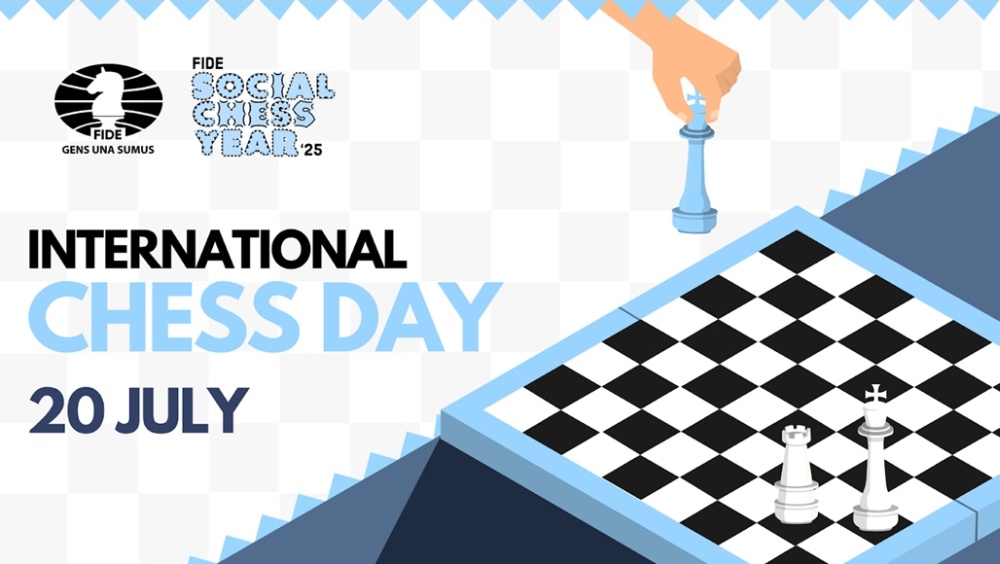
To mark International Chess Day 2025, FIDE invited players from across the globe to take part in the “Creative Chess, a challenge to set up games in the most unexpected, meaningful, or visually striking places. What followed was a wonderful outpouring of imagination, storytelling, and global connection, all united by one game. Barcelona, Spain Susie Sun shared a breathtaking moment featuring her children, Elliot and his sister, playing chess on a rooftop with the majestic Sagrada Família as their backdrop. “Surrounded by sky and spires still reaching for heaven, it became more than just a game, a moment of connection and wonder suspended in a city of dreams.” Mumbai, India A youth-led initiative called Chess for Change saw four friends- Aaditya, Nehan, Krish, and Vivaan, take chess to the heart of bustling Mumbai. They played games in locations that reflect the rhythm and soul of the city: a police jeep, a rickshaw, a temple doorway, a local train station, and even a dental clinic. “In a city that never stops moving, neither does a good game of chess.” Costa Rica Chess made its way to volcanic heights, with games played on the slopes of both Irazú Volcano and Arenal Volcano. Deep Dive Dubai, UAE At Deep Dive Dubai, the world’s deepest swimming pool, divers posed with a submerged chessboard. “Even a quiet game of chess becomes an unforgettable adventure.” Novato, California, USA Students at Hamilton K-8 School celebrated International Chess Day with a giant outdoor board as part of their summer camp, showing how chess can be a joyful part of school life and community. Bhaktapur, Nepal Jenish Tamang and Bede Saru Magar played in the ancient Bhaktapur Durbar Square, a UNESCO World Heritage Site. “Through these images, we aim to promote religious tolerance, peace, and friendship across the globe all united by our shared love for chess.” Antananarivo, Madagascar In Madagascar, a football field became a chess arena, showing that the game has a place wherever people gather to play and compete. Sligo, Ireland In a fairytale setting, one couple posed for wedding portraits on a giant outdoor chessboard. Arezzo, Italy Another touching love story emerged from Tuscany, where two players met over a chessboard on July 20th, not knowing they were beginning more than just a game. “Our daughter was then born in the city of Merano (like the Meran Variation), so chess seems to be the theme of our love story.” Even pets joined in on the fun, posing proudly at chessboards around the world. In Costa Rica, a curious iguana was spotted beside a riverside setup, blending nature and strategy in the wild. Meanwhile in China, top player Lei Tingjie’s fluffy dog also joined the celebration, posing sweetly at a board, dressed and ready to “make a move”. This year’s Creative Chess challenge was part of FIDE’s broader theme for 2025: Every Move Counts. Through each submission, we were reminded how chess can bring people together across cultures, generations, and even species. Thank you to everyone who joined this global celebration. Keep tagging your moments with #InternationalChessDay and #CreativeChess, and remember: the board may be 64 squares, but the world of chess is boundless.
FIDE Women’s World Cup Round 6 Game 1: Two solid draws in the semi-finals
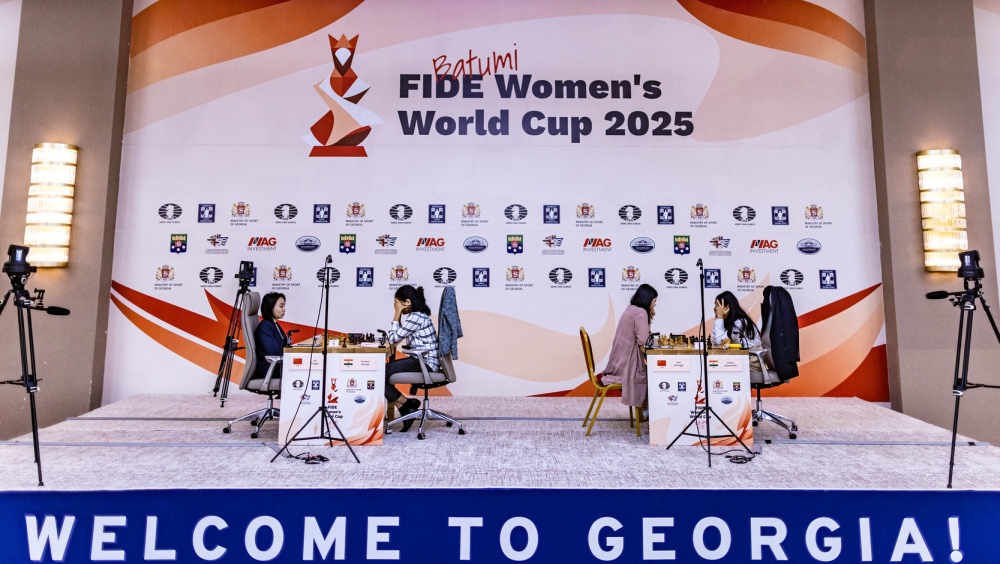
The stage is set for a thrilling showdown between China and India in the Women’s World Cup semi-finals. This afternoon, the first games of the two-game matches were played — and both encounters ended in hard-fought draws, leaving everything to be decided in tomorrow’s second games. Humpy Koneru surprised Lei Tingjie in the opening, prompting the Chinese Grandmaster to steer the game toward safer territory. It was a tense, strategic battle with both players feeling the pressure. “It was quite a tough game, not easy at all,” said Humpy in her post-game interview. “At some points I felt I was OK, but then I thought it was a bit dubious. I really don’t know what was going on.” A quieter affair on board two saw a relatively short and balanced game between the experienced Tan Zhongyi and India’s rising star, Divya Deshmukh. “I don’t have many thoughts on the game, as it was quite a short draw,” Divya remarked afterward. “I don’t think I was much worse at any point, but it could have definitely been slightly unpleasant if she had chosen the right ending.” Let’s take a closer look at the two games. Lei Tingjie vs Humpy Koneru (0.5-0.5) Lei opened with her usual 1.e4, but then spent ten minutes of her thinking time after Humpy’s fourth move. For the Indian GM, balancing new openings with her regular repertoire is not a problem. As Humpy explained after the game: “It’s quite standard to bring new openings to a tournament to have some new ideas. The Berlin Defence is quite a standard opening that has been played for many years.” After 1.e4 e5 2.Nf3 Nc6 3.Bb5 Nf6 4.O-O Humpy played 4…Ne7, an interesting alternative to the more popular 4…Bc5 and 4…d6. This line aims to reposition the knight via g6, reinforcing kingside control and avoiding early exchanges. Notably, 5.Nxe5 would be a serious mistake—Black responds with 5…c6, hitting the bishop, followed by 6…Qa5+, with a double attack on the king and the knight. Lei spotted the trap immediately but fell deep into thought on how to proceed, as there are many interesting possibilities. “I tried to sacrifice a pawn for piece play, but my opponent declined both times,” Humpy explained. Going into the middlegame, Lei had achieved a small edge based on slightly superior piece activity. On the clock, the situation was alarmingly equal — approximately half an hour left for each of them on move eighteen. But Humpy gradually neutralized Lei’s small initiative and even found chances of her own. “After I got in this …a6, …c4 and …Bc5 plan I think the position is quite comfortable for me,” Humpy explained after the game. The final interesting moment would have occurred if Humpy had captured a pawn that was up for grabs. Although the engine confirms that 35…Qxa4 is perfectly playable, Humpy didn’t like the idea of facing a direct attack after 36.f6!, which would have broken open the kingside around her castled king. “I didn’t like capturing that pawn at all, either directly or with a preparatory move. I just didn’t like that kind of position. My pieces are out of the game, and I preferred to keep things in control,” she explained. Her intuition, as it turns out, was spot on. Humpy played very sensible 35…Qd3 and a few moves down the road, the game was drawn. https://youtu.be/GoKTSeX_vUk Tan Zhongyi vs Divya Deshmukh (0.5-0.5) Against her opponent’s Queen’s Gambit Declined, Tan Zhongyi opted for an unexpected idea on move four—4.e3 instead of the more popular 4.Nc3 or 4.Bg5—forcing Divya to pause and think deeply. Checking recent games, I found that Tan had used this line before, notably against Hou Yifan and Ju Wenjun, suggesting it’s a quiet but deliberate part of her repertoire. “I didn’t expect 4.e3, so I took a few minutes to decide which variation I should go for,” Divya explained after the game. After careful consideration, she chose to steer the game into an isolated queen’s pawn (IQP) structure—an excellent strategic decision in response to Tan’s more restrained setup. In doing so, she followed in the footsteps of her compatriot, GM Vidit Gujrathi, who successfully employed the same approach in a 2021 encounter. On move eleven, Divya unveiled an impressive novelty: 11…Ba3!, an improvement over the more commonly played 11…Bb4+, seen in several master-level games. While 11… Bb4+ is also perfectly reasonable, 11…Ba3! had a surprising point. After 12.Bxa3 Qa5+, Divya immediately recovered the bishop, reaching full equality. Her isolated d-pawn was offset by active piece play — especially her queen on a3 — and pressure along the open files. In the following phase, after a series of exchanges and the liquidation of queenside pawns, the opponents simplified into a completely equal ending. A draw was agreed upon on move thirty. After the game, Divya took a few moments to share her thoughts in a short interview. https://www.youtube.com/watch?v=ChFDvDIDNhA Written by IM Michael Rahal (Batumi, Georgia) Photos: Anna Shtourman About the tournament: Scheduled to take place from July 6th to July 28th, the 2025 FIDE Women’s World Cup will gather together in Batumi (Georgia) the world’s best female chess players. A total of 107 players from 46 different federations are set to participate in the event, including seventeen of the current top twenty! Chess legends, seasoned professionals and emerging talents will play for the $50,000 first prize, in addition to three qualifying spots for the Candidates. The full pairings tree and day-by-day results can be found on the Women’s World Cup website.
August is for Women in Chess: Join the Global Women’s Chess Marathon
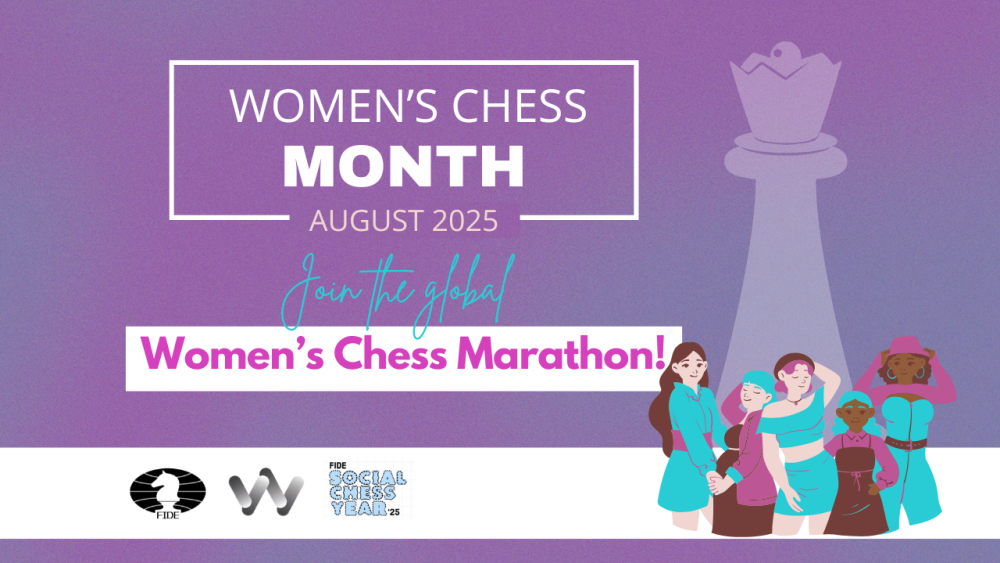
As part of FIDE’s 2025 Year of Social Chess, each month is dedicated to celebrating how chess can make a positive impact in society. This August, we shine the spotlight on Women in Chess — a month-long global celebration aimed at empowering women and girls through the game we all love. The FIDE Commission for Women’s Chess (WOM) is proud to lead this initiative and coordinate a variety of inspiring events around the world, including the Women’s Chess Marathon, highlighting the role of women in the chess community and encouraging inclusive participation across all levels. A Global Effort: Events Already Planned With the support of WOM, a vibrant lineup of events is already scheduled in 2 countries of each continent — Africa, America, Europe, Asia: Portugal Italy Australia Nepal South Africa Zambia Puerto Rico Venezuela These activities will range from tournaments and training sessions to workshops, exhibitions, and community outreach — all focused on engaging more girls and women in the chess world. Also, with support of ARB, WOM organize first ever only Women International Arbiter Seminar: Special Edition of the IA Seminar for WOMEN only – List of Participants! The Registration is closed! – Arbiters’ Commission Introducing the Women’s Chess Marathon August won’t just be about individual events — it will be a global marathon of efforts, stories, and celebrations. We’re calling it the Women’s Chess Marathon, and we want you to be a part of it! No matter where you are in the world, you can join the movement by organizing an event or activity for women and girls in chess during August. It can be as big as a tournament or as simple as a chess meetup, a school activity, or an online workshop. Every effort counts. Organizers — We Need You! Are you a chess club, federation, coach, teacher, or community leader? We invite you to: Plan a chess event that welcomes and empowers girls and women Highlight female role models in your community Create safe, inclusive spaces where more women and girls can thrive through chess Share your stories on social media using the hashtags #WomensChessMarathon and #WomenInChess, and tag @fidewomen on Instagram so we can amplify your efforts We’ll be sharing your initiatives on our platforms throughout August, celebrating the incredible work being done around the globe. Let’s Make August Unforgettable Let’s work together to make August a month that truly reflects the presence and passion of women and girls in chess. The Women’s Chess Marathon isn’t necessarily about big campaigns. It’s about real people, real events, and real effort — from small local meetups to international tournaments. Every activity matters. If you’re helping more girls and women feel welcome in chess, you’re part of this. We can’t wait to see what you create. Let’s make it a month to remember — together. For questions, support, or to share your planned activities with us directly, email to our coordinator: anna.kantane@gmail.com

